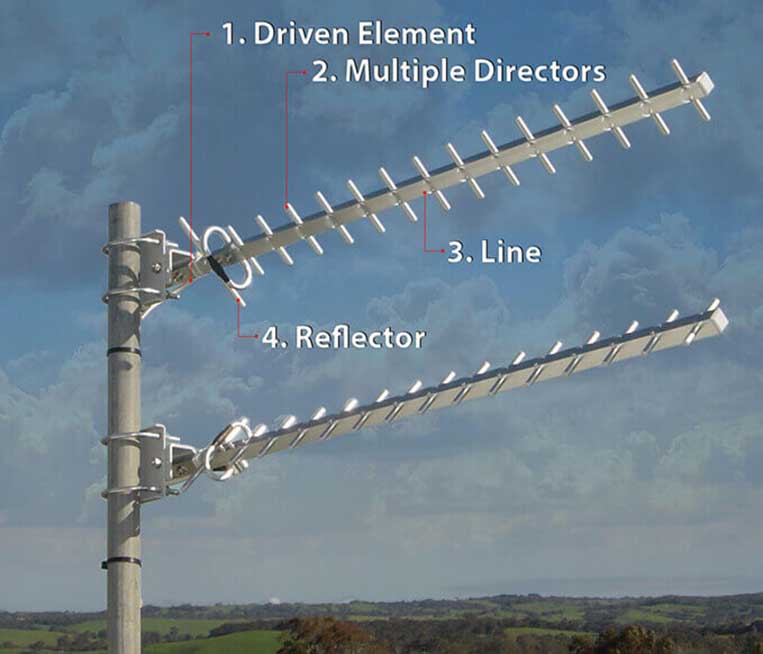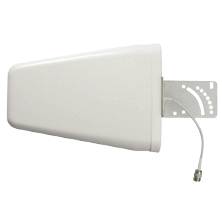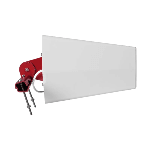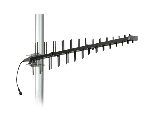Directional Donor Antennas Explained: Yagis & LPDAs
Get Stronger Cell Signal with the Right Directional Antenna
One of the most important components of a cell signal booster is the outdoor or donor antenna. Its job is to capture existing 4G and 5G signals from nearby cell towers and send them to your booster, which amplifies and rebroadcasts them indoors for clearer calls, faster data, and stronger overall connectivity.
There are two types of cellular outdoor antennas: omnidirectional and directional. In this guide, we’ll break down directional donor antennas, the kind that zero in on one tower for a stronger, clearer signal, focusing on Yagi and LPDA options and how to choose the right one.
What is a Directional Antenna?
A directional antenna is designed to send and receive signal from one specific direction, kind of like a flashlight beam instead of a lantern’s glow. Rather than collecting signal from every tower around you (like an omnidirectional antenna does), it focuses on just one, which helps pull in a stronger and cleaner connection.
This focused design means directional antennas can reach farther distances than omnidirectional ones and deliver better data speeds and call quality, especially in rural or low-signal areas. A tradeoff, though, is that they need to be aimed precisely toward your nearest or strongest cell tower to work their best. The more directional the antenna is, the narrower its radiation beam, requiring more precise aiming.
If you live in a city or have multiple towers nearby, an omnidirectional antenna might make more sense. But if your goal is to boost your cell signal from a specific tower, a directional antenna is often your best bet.
Types of Directional Donor Antennas
There are two main directional antennas for cell signal boosters: Yagi and LPDA. Both aim at one tower to pull in a stronger signal. The LPDA just takes that focus a step further.
Yagi Directional Antennas
The Yagi (also known as Yagi-Uda) is the classic “TV-style” antenna with several metal elements lined up along a central bar. It’s one of the most reliable and widely used options for cell signal boosting because it’s simple to install, relatively forgiving to aim, and powerful enough to make a big difference in rural or suburban areas.
How Yagis Work
Yagis work by focusing on one direction to collect signal from your nearest or strongest cell tower.
Inside the antenna, four key components work together: a driven element that connects to your booster, directors that increase forward gain, a reflector that blocks unwanted signals from behind, and a line that serves as the spine, holding the elements in place and connecting them together.

Together, these parts help the antenna focus energy in one direction, similar to how a mirror reflects light. This design gives it higher gain and better reach than an omnidirectional antenna.
Typical performance:
- Gain: ~8 – 9.2 dBi
- Beamwidth: wider than LPDA, roughly 45–90° (more forgiving to aim)
- Reach: up to ~5 miles from the tower (best results often within ~3 miles, terrain-dependent)
This type of directional antenna is best for homes and businesses located up to 5 miles from a cell tower. Here are two examples:

Built for exterior installs to capture stronger outdoor signal for your booster. It supports all major cellular bands (LTE, CDMA, GSM, UMTS, AWS), features a UV-stable weatherproof radome, and mounts easily with a tilt/swivel bracket that fits 1.25" to 2" masts. 50 Ohm, it pairs best with commercial cell phone boosters.
Shop Now: $89.99
Delivers reliable outdoor performance for stronger cell signal. Compatible with all global cellular bands, it’s optimized for exterior installation and precise tower alignment. Its durable, UV-stable housing stands up to any weather, and the included tilt/swivel bracket makes installation easy on 1.0" to 3" diameter masts. 75 Ohm, it pairs best with residential cell phone boosters.
Shop Now: $99.99LPDA Directional Antennas
The Log-Periodic Dipole Array (LPDA) antenna is a high-performance directional antenna designed for long-range and wide-frequency coverage. It looks similar to a Yagi, but it features a series of dipole elements spaced at varying intervals along its line. This design allows it to work efficiently across multiple cellular frequency bands while maintaining a strong, focused signal.
How LPDAs Work
An LPDA antenna uses multiple dipole elements connected by a feedline that zigzags along its length. Each dipole is tuned to a different frequency, allowing the antenna to capture a wide range of signals within the 698–2700 MHz cellular band. Because of this, an LPDA delivers higher gain and a narrower focus than a Yagi, making it one of the most powerful options for boosting weak cell signal.
Typical performance:
- Gain: ~10 – 13 dBi
- Beamwidth: narrower than Yagi, roughly 30–50° (requires precise aiming)
- Reach: up to ~10 miles from the tower under ideal conditions
This type of directional antenna is best for homes and businesses located at the edge of network coverage or in areas with high interference that need the cleanest possible donor signal. Since this design is so directional, it does not pick up all the noise outside its radiation beam. Here is one example:

A powerful directional antenna designed for exterior installation and long-range performance. Compatible with all global cellular networks, including LTE, CDMA, GSM, UMTS, and AWS, it delivers exceptional gain for use with signal boosters and repeaters. Built with durable, weatherproof materials, it provides reliable operation in any environment and installs easily with included mounting hardware for precise tower alignment.
Shop Now: $249.99Directional Antenna Pros and Cons
Directional antennas offer excellent performance for boosting weak cell signal, but they also require more effort to install and aim correctly.
Pros of Directional Antennas
Directional antennas can reach much farther than omnidirectional models and provide a cleaner, stronger connection by focusing on one tower instead of trying to pull in signal from every direction. They are ideal for rural or remote areas where nearby towers are limited, and they help minimize interference or “signal noise” from surrounding sources.
Cons of Directional Antennas
Because they focus on one direction, directional antennas need to be aimed precisely toward the desired cell tower. This can take some trial and error, especially in areas with multiple towers nearby or obstacles that block line of sight. They are not the best choice for mobile use or for environments where signals come from many different directions.
Yagi or LPDA? Which is Better for Me?

Now that you know the general pros and cons of directional antennas, the next step is deciding which type best fits your setup. Both are designed to focus on a single tower and deliver a strong, stable signal, but they differ in range, precision, and use cases.
| Feature | Yagi Antenna | LPDA Antenna |
| Range | Up to 5 miles | Up to 10 miles |
| Beamwidth | Wider (45–90°) | Narrower (30–50°) |
| Gain | 8–9.2 dBi | 10–13 dBi |
| Ease of Aiming | Easier to aim | Requires precise alignment |
| Best For | Homes and small offices with moderate distance from towers | Remote locations or high-interference areas needing the cleanest signal |
| Price Range | Generally lower | Higher due to increased performance |
If you are within a few miles of a tower and want a quick, reliable setup, a Yagi antenna is often the most practical choice. If you are located farther out, at the edge of the network coverage, or need to cut through signal noise, an LPDA antenna will give you the extra reach and performance you need.
How to Aim a Directional Antenna
Getting your directional antenna aimed correctly is the key to strong, consistent performance. Since these antennas focus on a single tower, the first step is to find the direction of your nearest or strongest cell tower. If you are wondering, “What direction do I point my antenna?,” you can use our cell tower locator guide to identify the exact location of your carrier.
Once you know where your tower is, mount the antenna outdoors in a spot with the clearest line of sight. This is usually on a roof, pole, or high exterior wall. Avoid placing it behind trees, metal, or other large obstacles that could block the signal.
Point the antenna toward the tower and check your booster’s signal readings. You can see our guide on measuring signal strength to learn how. If you’re using an LPDA antenna, remember that its narrower beamwidth means even small adjustments can make a big difference. Take your time and fine-tune the angle until you see the strongest signal possible.
If you have a few towers nearby, try aiming at each one to compare results. Some towers broadcast stronger and clearer signals than others, even within the same network.
Installation tips:
- Mount the antenna as high as safely possible for a clearer path to the tower.
- Keep at least 50 feet of separation between outdoor and indoor antennas to prevent oscillation (feedback).
- Use weatherproof cable connections and secure all hardware to prevent movement in high winds.
Frequently Asked Questions
What is the range of a Yagi antenna?
What is the range of an LPDA antenna?
Can I use two directional antennas?
Does the orientation of a directional antenna matter?
What is the difference between a Yagi and an LPDA antenna?
What is the difference between a directional and omnidirectional antenna?
Ready to Boost Your Cell Signal? Let’s Find the Right Antenna
Directional antennas are some of the most effective tools for improving weak cell signal. By focusing on a single tower, they deliver stronger, cleaner connections, especially in rural, remote, or high-interference areas.
Yagi antennas are a reliable choice for homes and small offices within five miles of a tower, while LPDA antennas are better suited for long-range or edge-of-network locations that need every bit of signal strength possible.
Not sure which type is right for your setup? Call our signal experts at Wilson Amplifiers at 1-800-568-2723 for free, personalized advice. We’ll help you find the best antenna and booster combination to get the strongest signal wherever you need it most.
Interested in Learning More? Check Out Our Signal Boosting Info Center


Money Back Guarantee

Technical Support